- The Bay of Bengal Initiative for Multi-Sectoral Technical and Economic Cooperation (BIMSTEC) is a regional organization comprising of 7 member states which are in the littoral and adjacent areas of Bay of Bengal, thus constituting a contiguous regional unity.
- Formation: Formed in 1997 through the Bangkok Declaration.
- It was initially formed with 4 member states (Bangladesh, India, Sri Lanka and Thailand). Myanmar became a member in 1997, followed by Nepal and Bhutan in 2004.
- BIMSTEC has celebrated 20 years of its formation in 2017.
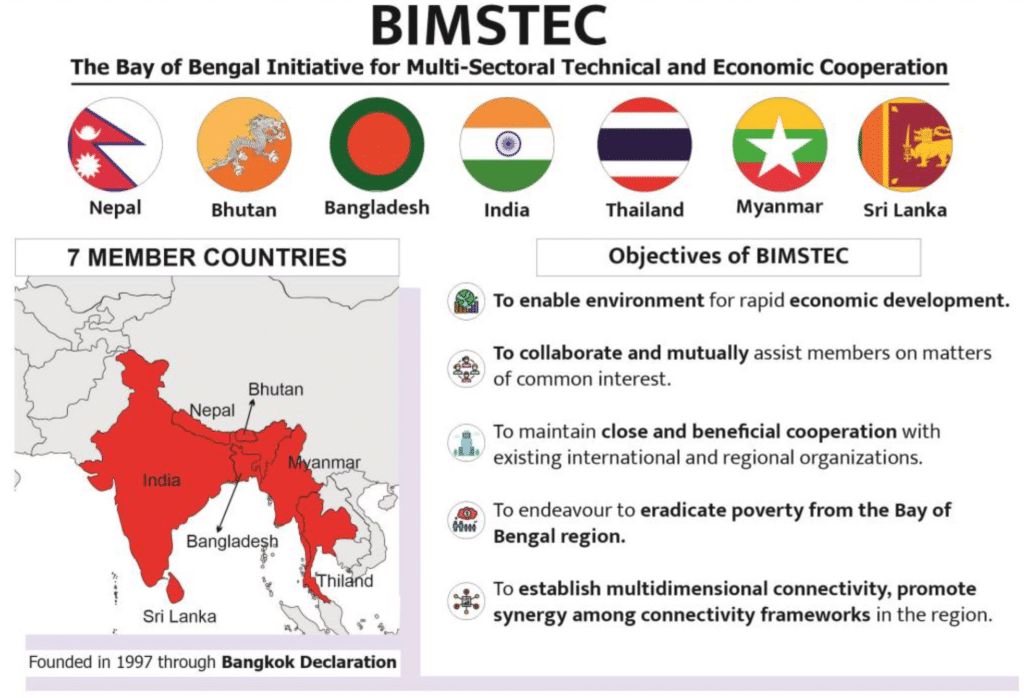
Membership
- South Asian Countries:
- Bangladesh
- Bhutan
- India
- Nepal
- Sri Lanka
- South East Countries:
- Myanmar
- Thailand
- Headquarters: Dhaka, Bangladesh
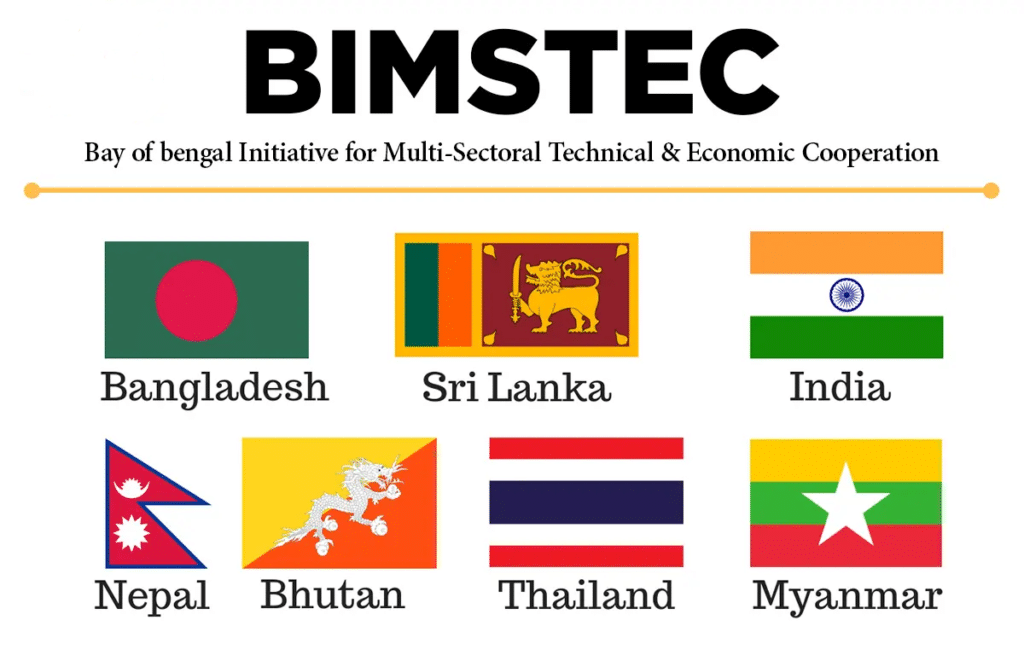
Objectives
- To create an enabling environment for rapid economic development through identification and implementation of specific cooperation projects in the sectors of trade, investment and industry, technology, human recourse development, tourism, agriculture, energy, and infrastructure and transportation.
- To accelerate the economic growth and social progress in the sub-region through joint endeavors in a spirit of equality and partnership.
- To promote active collaboration and mutual assistance on matters of common interest in the economic, social, technical and scientific fields.
- To provide assistance to each other in the form of training and research facilities in the educational, professional and technical spheres.
- To cooperate more effectively in joint efforts that are supportive of and complementary to national development plans of Member States which result in tangible benefits to the people in raising their living standards, including generating employment and improving transportation and communication infrastructure.
- To maintain close and beneficial cooperation with existing international and regional organizations with similar aims and purposes.
- To cooperate in projects that can be dealt with most productively on a sub-regional basis and make best use of available synergies among BIMSTEC member countries.
- It was formed to harness shared and accelerated growth through mutual cooperation in different areas of common interests by mitigating the onslaught of globalization and by utilizing regional resources and geographical advantages.
- It is a sector driven cooperative organization, with 14 sectors identified for cooperation. Some of these sectors are: energy, transport, tourism, counterterrorism, environment, culture, people to people contact, climate change, agriculture, poverty alleviation, etc.
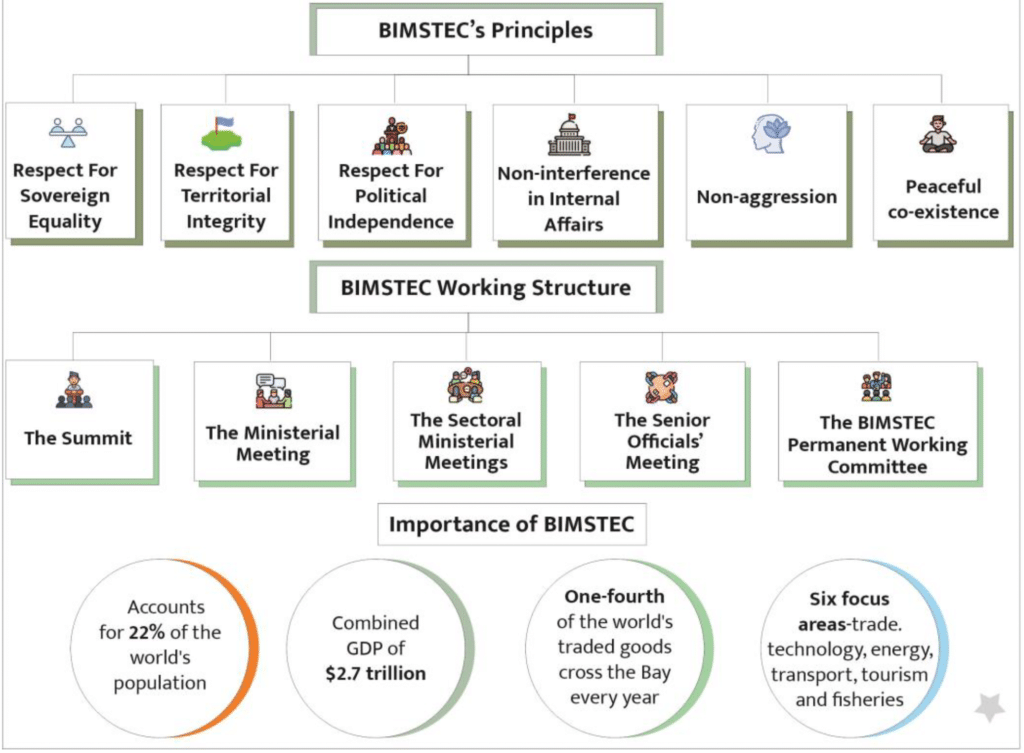
Founding Principles
- Cooperation within BIMSTEC will be based on respect for the principle of sovereign equality, territorial integrity, and political independence, non-interference in internal affairs, peaceful coexistence and mutual benefit.
- Cooperation within BIMSTEC will constitute an addition to and not be a substitute for bilateral, regional or multilateral cooperation involving the Member States.
Significance
- BIMSTEC countries are home to around 1.5 billion people, constituting 22% of global population, and represent a combined GDP of $ 3.5 trillion.
- The region constitutes a bridge between South and South East Asia, and represents a reinforcement of relations among these countries.
- The Bay of Bengal region has the potential to become the epicentre of the Indo-Pacific idea, a place where the strategic interests of the major powers of East and South Asia intersect.
- BIMSTEC has established a platform for intraregional cooperation between SAARC and ASEAN members.
- A fourth of the world’s traded goods cross the bay every year.
- Important Connectivity Projects:
- Kaladan Multimodal Project – links India and Myanmar.
- Asian Trilateral Highway – connecting India and Thailand through Myanmar.
- Bangladesh-Bhutan-India-Nepal (BBIN) Motor Vehicles Agreement – for seamless flow of passenger and cargo traffic.
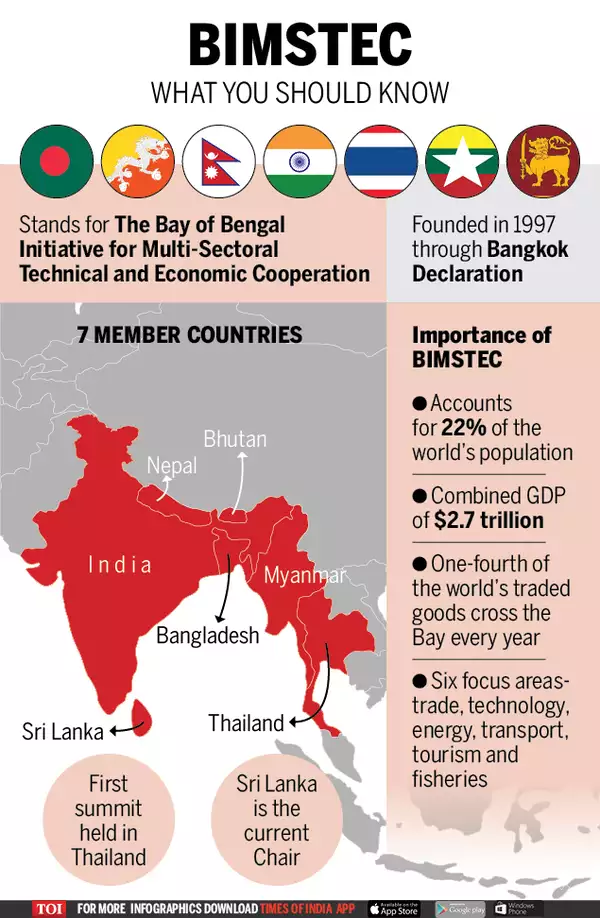
Significance for India
- India is the biggest member of BIMSTEC; therefore, India has to make BIMSTEC effective to show leadership at the international level.
- With SAARC being rendered virtually ineffective as a bloc, largely due to non-cooperation from Pakistan in many areas, India is giving more importance to BIMSTEC in recent times.
- BIMSTEC is an opportunity for India to engage with Southeast Asian countries.
- It provides India with scope for:
- Direct connectivity with Southeast Asia via North-East India and Myanmar.
- Potential access to alternative energy resources in Myanmar.
- Economic opportunities which are available in ASEAN region.
- Allows India to pursue three core policies:
- Neighborhood First – primacy to the country’s immediate periphery;
- Act East – connect India with Southeast Asia; and
- Economic development of India’s northeastern states – by linking them to the Bay of Bengal region via Bangladesh and Myanmar.
- Allows India to counter China’s creeping influence in countries around the Bay of Bengal due to the spread of its Belt and Road Initiative.
- A new platform for India to engage with its neighbors with South Asian Association for Regional Cooperation (SAARC) becoming dysfunctional because of differences between India and Pakistan.
Developments
- Recently, India hosted the first BIMSTEC army exercises “MILEX 2018” in Pune. This is a success considering the fact that neither SAARC nor the ASEAN have had such a military component.
- BRICS-BIMSTEC Outreach summit was held at Goa in October 2016. This highlights the importance of BIMSTEC for India.
- India has announced that it is seeking to expand UDAN (Ude Desh ka Aam Nagrik) scheme to BIMSTEC countries.
- The grouping has identified 14 priority sectors, and has signed a Free Trade Agreement (in 2004), and a Convention on Cooperation in Combating International Terrorism, Transnational Organized Crime and Illicit Drug Trafficking (in 2009).
- India has signaled its renewed interest in the grouping. It is already the lead country for 4 priority sectors: transportation and communication, environment and disaster management, tourism, counter-terrorism and trans-national crimes.
- BIMSTEC is trying to sign a Convention on Mutual Legal Assistance in Criminal Matters.
- Goa declaration stated that BIMSTEC needs to have a Coastal Shipping Agreement to allow member states to trade feely within the sub-region.
Issues and Challenges
- Despite its huge potential in terms of enhancing regional cooperation, BIMSTEC has long suffered from lack of resources and proper coordination among its member states. This can be seen by the fact that so far only four high-level summits have been held; and it took 17 years for BIMSTEC to establish its permanent secretariat in Dhaka in 2014.
- Both Nepal and Thailand chose to opt out of MILEX 2018 and preferred to remain observers signaling poor interest in security dialogues and counterterrorism efforts.
- Country specific criticisms are:
- Thailand and Myanmar are criticized for ignoring BIMSTEC in favour of ASEAN.
- India (largest member in the grouping) has been criticized for not providing a strong leadership to the grouping.
- Key institutional factors which held back BIMSTEC were absence of a permanent secretariat for a long time and lack of commitment to invest in several priority areas.
- Inconsistency in Meetings: BIMSTEC planned to hold summits every two years, ministerial meetings every year, but only four summits have taken place in 20 years upto 2018.
- Neglect by member states: It seems that India has used BIMSTEC only when it fails to work through SAARC in the regional setting and other major members like Thailand and Myanmar are focused more towards ASEAN than BIMSTEC.
- Broad Focus Areas: The focus of BIMSTEC is very wide, including 14 areas of cooperation like connectivity, public health, agriculture etc. It is suggested that BIMSTEC should remain committed to small focus areas and cooperate in them efficiently.
- Bilateral Issues between Member Nations: Bangladesh is facing one of the worst refugee crisis of Rohingyas from Myanmar who are fleeing prosecution in the state of Rakhine in Myanmar. There is a border conflict between Myanmar and Thailand.
- BCIM: The formation of another sub-regional initiative, the Bangladesh-China-India-Myanmar (BCIM) Forum, with the proactive membership of China, has created more doubts about the exclusive potential of BIMSTEC.
- Inadequate Focus on Economic Cooperation: A quick look at the unfinished tasks and new challenges gives an idea of the burden of responsibilities on the grouping.
- Despite signing a framework agreement for a comprehensive Free Trade Agreement (FTA) in 2004, BIMSTEC stands far away from this goal.
- Of the seven constituent agreements needed for the FTA, only two are in place as of now.
- Unfinished Projects: The general formulations of the Colombo Declaration (fifth BIMSTEC Summit) instil little confidence about prospects of early progress.
- Despite talks for the need for expansion of connectivity, much of the work is unfinished when it comes to finalising legal instruments for coastal shipping, road transport and intra-regional energy grid connection.
Way Forward
- The renewed interest among the members should be harnessed by India by providing the grouping a strong leadership and taking initiatives. The ongoing projects should be implemented efficiently, and new projects should be initiated.
- For BIMSTEC to become an enabler of regional cooperation, it would have to evolve as an organisation that works through a bottom-up rather than a top-down approach.
- People centric approach might work for BIMSTEC as it seriously lags behind ASEAN and other regional organizations in terms of people-to people contacts.
- The organization needs to focus on fewer priority areas for purpose of better implementation.
- Projects which are economically feasible and result-driven should be taken up at this point. This would make BIMSTEC more credible, and boost the enthusiasm of its members.
- BIMSTEC region is notable for its diversity. So its member states should build on the regional synergies, and work towards utilizing the available resources in the most optimal manner.
- Multilateral Discussions: Given the complexity of domestic and geopolitical factors, this sphere will require sustained bilateral and group-level discussions to prevent problems such as the Rohingya crisis from becoming impediments to the smooth delivery of economic and security outcomes.
- India too will have to ensure equally sustained political engagement with partners such as Nepal, Sri Lanka and Bangladesh to prevent any domestic political spillover from affecting bilateral and group-level working relationships.
- India and other members will also need to be astute in managing Myanmar’s engagement until the political situation in the country becomes normal.
- Boosting Connectivity and Cooperation: For India’s vision to bolster trade connectivity in the grouping, an FTA spanning the maritime resource-rich members such as Myanmar and Sri Lanka could bring dramatic gains for all members.
- A ‘coastal shipping ecosystem’ and an interconnected electricity grid, in addition to the adopted Master Plan for Transport Connectivity, have the potential to boost intraregional trade and economic ties.
- Also, BIMSTEC needs to generate additional funding and push for timely implementation of the projects.
- India as the Torchbearer: For the revived grouping to realise its trade and economic potential, India will have to take a leadership role in assuaging any apprehensions among the smaller members of intragroup power imbalances and strive to facilitate greater cross-border connectivity and flow of investments by lowering barriers to the movement of people and goods.
- Even at the summit, India was the only country to offer additional funding to the Secretariat and also to support the Secretary General’s proposal to establish an Eminent Persons Group (EPG) for producing a vision document.
- Other countries need to emulate this sincere matching of words with action.
- Others Areas of Focus: BIMSTEC should focus more in the future on new areas such as the blue economy, the digital economy, and promotion of exchanges and links among start-ups and Micro, Small and Medium Enterprises (MSMEs).
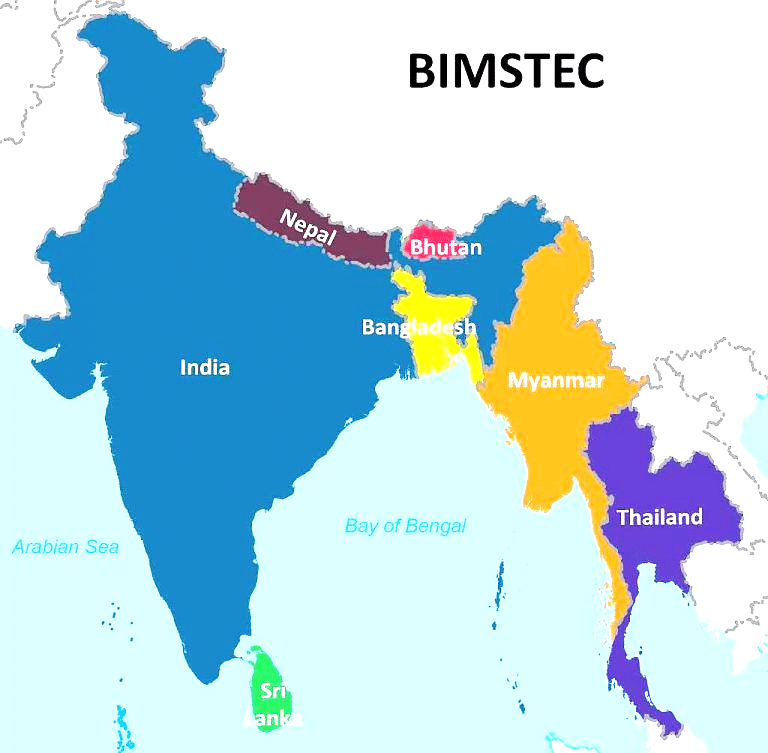
How BIMSTEC is Different from SAARC?
| SAARC | BIMSTEC |
|---|---|
| 1. A regional organisation looking into South Asia 2. Established in 1985 during the cold war era. 3. Member countries suffer for mistrust and suspicion. 4. Suffers from regional politics. 5. Asymmetric power balance. 6. Intra-regional trade only 5 percent. | 1. Interregional organisation connecting South Asia and South East Asia. 2. Established in 1997 in the post-Cold War. 3. Members maintain reasonably friendly relations. 4. Core objective is the improvement of economic cooperation among countries. 5. Balancing of power with the presence of Thailand and India on the bloc. 6. Intra-regional trade has increased around 6 precent in a decade. |

excellent content.. Thanks a ton to the whole team.
Keep Reading.
Best IR content on the Internet.
Hats off to the team , keep up the good work